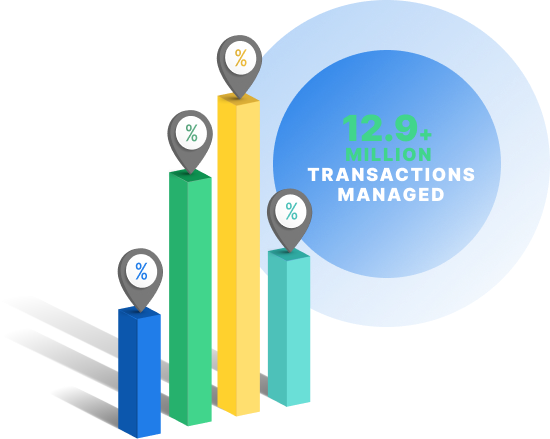Since its creation, mobile text messaging has taken the world by storm.
It’s now one of the most common ways people communicate since it’s shorter and more convenient than making an actual phone call. Plus, long-distance rates don’t apply, and extra text messages only cost a couple of cents if someone happens to go over their plan’s limit.
So if it’s such a great communication tool, why don’t more people use it for marketing?
It’s hard to say — text messaging is easy to incorporate into your marketing team’s overall strategy. All you have to do is set it up.
In this guide, we’ll discuss how you can do exactly that while making sure you don’t cross any lines or run into legal trouble.
But first, let’s touch on what text message marketing actually entails.
What is text message marketing?
Text message marketing is the process of engaging your customers by sending them pre-written messages that encourage them to go to your website and convert into a customer.
If you’ve ever used email marketing, this might already sound familiar. The only difference is that you’re sending a message specifically to someone’s mobile phone.
But if SMS vs. email marketing is so similar, what’s the need for text message marketing in the first place?
People check their phones more often than they check their email. Phones automatically notify owners of new text messages, but they may not tell users about new emails.
For marketers, that means you have a higher chance of someone opening your message and reading it.
Plus, you don’t have to think of any subject lines for your text messages — you only need to create the actual message content.
And on top of that, there’s the chance that you can catch someone on their phone right as they’re looking at your website or shopping at your store. That means you can encourage conversions as your customers are involved with your company!
So at the end of the day, you’re working with shorter, simpler, and more direct messages that link back to your website, and there’s a much higher chance that someone will actually read them.
It’s the streamlined and simplified version of email marketing!
Legal concerns
Just like with email marketing, you have a handful of legal concerns whenever you start using text message marketing.
Spam
Similar to email, you can’t simply pull someone’s phone number and start sending them unsolicited text messages. That’s spamming, and it can absolutely destroy your company’s credibility and customer base.
Instead, you should ask for your customers’ phone numbers with the disclaimer that they’ll receive text messages from you on occasion.
That way, just like with your email list, customers know exactly what to expect when they give you their information.
Billing
You’ll also need to address billing concerns.
People don’t pay for emails they receive by the message. But they do pay for each text message, whether those messages are part of a plan or not.
That means you have to remind your customers that standard text messaging rates may apply to the messages they receive. If they don’t understand that, they may wind up paying extra for the texts that you send them, and that could land you in a big disagreement about liability.
To cover your company — and be kind to your customers — make sure they understand that it costs money to send and receive text messages.
Restricted numbers
This overlaps with spam, but it’s essential to know that you can’t ever send unsolicited messages to people on the National Do Not Call Registry.
On top of that, you also can’t send messages to children under the age of 18. That means if your company wants to market directly to young teens or kids, text message marketing simply isn’t in your ballpark.
Restricted products
Finally, it’s critical that you’re familiar with the kinds of products that you can and can’t market via text in your state.
Products like weapons, alcohol, tobacco, and pornography are strictly regulated in terms of marketing, especially when minors are involved.
With some industries, like alcohol, you may not even be able to market to someone based on the state in which they live.
For example, if someone from Pennsylvania comes to your store in Delaware to buy liquor, and they sign up for text message alerts, you could violate Pennsylvania’s liquor laws by following up with them.
The same could be true for any “dry” municipalities throughout the United States. It’s important to research these restrictions for your industry long before you start a text message marketing campaign. If you don’t, you could wind up paying more in fines than you make from customers.
(And just for reference, those fines can be anything from $500 to $1500 per message.)
Looking for an all-in-one SEO audit tool? You've found it.
SEO Checker provides data on key metrics to give you:
- Complete SEO score
- Content Grade
- Site Speed Analysis
- and more.

Text message marketing best practices
Now that you’re sure you can use text message marketing without any legal repercussions, it’s time to move forward with your campaign.
There are nine ideas that you must incorporate into your text message marketing strategy to make sure you’re getting the best possible results.
1. Tell users exactly what to expect
When you’re asking people for their phone numbers, you need to make it perfectly clear to them what they can expect from you.
The best way to do this is to tell them when you’ll send text messages, how often you’ll send them, and what they’ll offer.
You should include all of this information in your Terms & Conditions. That way, your customers will know where to find it, and they’ll understand that they have to read it.
Beyond that, you can also add a checkbox to your signup form that every user must click to confirm that they understand your terms and conditions. That absolves you of any liability if someone later complains that they didn’t know what you would send to their phones.
Finally, it’s a great idea to create a confirmation text message that you send to every new signup. Confirmation messages are great for making sure that you have the right number and your customer sincerely wants to get messages from you.
Now that you have all the logistics worked out, it’s time to decide on some other critical details.
2. How often you send text messages
The frequency of your text messages plays a major role in how they’re received.
If you send multiple text messages per day, you can expect your list of recipients to drop off almost immediately. That’s because you’re sending messages too frequently, and can start to resemble spam to consumers.
However, if you only send one or two messages per week, you’ll have a much better chance of retaining a strong list of recipients.
In fact, you should shoot to only send one text message per week that promotes your company, and you should send it at roughly the same time each week. That helps customers learn when to expect your messages, and can create a sense of consistency.
It may not seem like it means much, but when someone knows when to expect your message, they can respond to it or even start to look forward to it. It’s a little detail that can make a big difference.
3. Only text during reasonable hours
As part of establishing regular contact hours, it’s best to send text messages during reasonable hours as well.
“Reasonable hours” are the times when most people are awake and active, typically between 10:00 a.m. and 8:00 p.m.
That ten-hour window is a great time to reach your audience. You can further refine your “reasonable hours” to make sure you’re appealing to your demographic the best ways possible.
For example, if your demographic is decision-makers in local businesses, it’s probably smarter to send text messages during lunch or evening hours to avoid interrupting their days. That also gives them enough time to follow up with your message instead of seeing it, intending to answer it later, and forgetting.
Regardless of who you’re trying to reach, it’s a bad idea to send messages in the middle of the night or early morning.
Nobody wants to hear from a company at 3:00 a.m., and if you wake someone up, they’re not going to be happy to see that you’re responsible for interrupting their sleep.
To avoid that possibility altogether, it’s best to stick to the “normal” hours that people are awake and active during the day.
4. Write conversationally
The goal of almost all Internet copywriting is to sound conversational. A conversational tone is essential for engaging and connecting with your audience, and it makes even more sense to do it with text messages.
After all, text messages are about as informal as communication gets. And when’s the last time you saw someone using a proper salutation and farewell in a text?
The only time you would need to use those kinds of formalities is if it’s appealing to your audience.
Otherwise, you can keep the tone conversational, almost like someone’s hearing from their friend through a text.
That’s the goal of text message marketing, after all — familiarity. You’re reaching someone on their personal phone, and smartphone owners can jump to your site straight from your message.
When you sound more like a friend, someone that the recipient trusts and appreciates, you can maximize the chances of bringing that recipient to your site for a sale.
You can use text speak or text lingo, if that works for your audience.
Basically, you have 160-some characters to create a smart, concise, and compelling message — and it starts with writing the same way you talk.
5. Offer something valuable
Along with writing conversationally, you need to have a point to your text message. Otherwise, you’re not offering anything to your recipients.
And if you don’t offer something to your marketing prospects, you can’t expect them to stick around for long.
That’s why you should offer something compelling with every text message you send. Are you sending a coupon code? A link to valuable information? A new feature that customers could enjoy?
Regardless of what it is, each message you send needs to have a point. You should also couple that point with a strong (but short) call to action that compels each recipient to take action.
Your call to action can be as simple as “Learn more” or “Click to shop,” or however else you’d like to get customers to your site.
The key is that you use the right call to action to get recipients back on your website.
Combined with your value proposition, you’ll have just enough space to write a quick message with a link back to your site.
6. Customization
Do you know what’s better than hearing from your favorite brand in regular intervals, right on your phone?
Choosing what they tell you!
Customization options are a great way for you to show users that you’re serious about your text message marketing campaigns, to the point where you care about what they want to hear from you.
You can even use this section to let customers choose the times they’d like to hear from you. That eliminates all of the guesswork associated with timing, and you can reach your customers when they’re at their most receptive.
If you have the development power, you can incorporate any of the following customization options into your text message marketing campaigns:
- Best time to get text messages
- Morning, afternoon, or evening
- Exact hours
- What kind of messages to get
- Promotions
- Coupons
- Personalized offers
- Company news
- Blog updates
- Account alerts
- Events
- How many messages to get each month
- Four is a good default
- Any additional messages should be optional
Customization options may not sound like much, but they can give your messages a little extra personal touch that’ll resonate better with your current and prospective customers.
Customization lets you engage and appeal to people as individuals, as opposed to speaking to them as a uniform group.
And once you make that personal touch of talking to someone about their needs and their aspirations, you take your marketing to a new level of streamlined efficiency and effectiveness. Also, you can use some of the best sms marketing software available online to help you best customize your messages.
7. Let recipients unsubscribe
Finally, when you’re working with text message marketing, it’s essential to give your recipients a way to unsubscribe.
It’s one of the least fun features to implement as a marketer, but it’s essential to your company’s success.
The reason is because people who want to hear from you make great customers — but people who don’t want to hear from you aren’t helping your business.
In fact, they might even be hurting your business if they’re telling other people that they can’t unsubscribe from your text messages.
So they’re not qualified leads, and they could hurt your business. You might as well let them go!
You can implement an unsubscribe function by creating a keyword — like STOP — that takes someone’s phone number out of your recipient list. Then, when a subscriber replies to your texts with that word, they never hear from you again (unless they sign up again).
Adding an unsubscribe feature may be counterintuitive, but it’s a great way to make sure you’re only marketing to people who are receptive to your messages.
8. Use five-digit phone numbers
If you’re going to invest heavily into text message marketing, you should get an entirely new phone number for it.
These text-only numbers, sometimes called “short codes,” allow you to easily communicate with your potential customers on a text-exclusive channel that lets them hear what you have to say, participate in your marketing, or unsubscribe.
That keeps your regular phone lines open for any other kind of business-related calls or messages, as your dedicated SMS line continually sends new messages.
Using a short code also makes it easier for customers to remember your texting number so they can inquire about your business whenever they want.
When you get a short code, you can either have a dedicated or shared line. Dedicated lines take longer to set up and typically cost more. Shared lines are typically already set up, cost very little, and send messages to your business based on keywords your recipients use if they text you back.
If you plan to use text message marketing frequently with a long list of numbers, a dedicated line is the best solution for you.
But if you’re a small-town restaurant who wants to send customers a special thank-you and a coupon on their birthdays, you can probably work with a shared line for your short code.
9. Listen to your carrier
Just like how your Internet service or email provider can blacklist you for sending spam, cell service providers and text message providers can flag you for texting too much.
The good news is that they’ll warn you before you’re flagged, so that you can adjust your strategy.
But at the end of the day, your carrier is your lifeline from your business to your customer. You can’t use text message marketing at all without them, and that means you have to listen to their guidelines and recommendations.
It’s a similar situation with performing SEO for Google. If Google discovers your site is disreputable, they’ll give you enough warnings so you can change your SEO strategy.
If you listen, they’ll keep you in their results so your company can continue to profit from organic SEO.
If you don’t listen, they may penalize you in rankings or remove you from their index entirely, which can bring your Internet marketing to a quick halt.
For those reasons, it’s best for your marketing if you avoid biting the hand that feeds you whenever possible.
We don’t want to tell you about the work we do, we want to SHOW you.
View Our Portfolio
We’ve built over
Websites
in a variety of industries.
When to use text message marketing
Like any marketing strategy, text messages are best utilized at certain times and under certain conditions.
We’ve already established some of the best practices. Now, let’s consider some conditions when you should send texts to your potential customers.
1. Automatic responses to sign-ups
Auto-responses are one of the best ways for your company to immediately follow up with a new lead.
These responses can contact your potential customers and say any number of things. The most common are simple thank-yous and confirmations.
But you can also use auto-responses to tell someone that they’re automatically enrolled in your text message marketing campaigns, giving them the chance to stay in your marketing funnel or withdraw from texts.
That allows your customers to have greater control over how you communicate with them, which improves your relationship with each individual.
Plus, sending automatic responses to sign-ups tells your potential customers that you’re serious about working with them one-on-one. You want to give them the personalized experience that’ll meet their needs, and they can respond however they’d like.
This gives your marketing recipients much greater control over how they interact with your company.
2. Customer surveys
If you want to know that your business is satisfying your customers, you can ask them via text.
These surveys don’t have to be extensive, and you can either send someone a link to website or allow them to respond directly to your text.
The link option works great for longer surveys, and the direct response option is perfect for one-question surveys.
A good example of a long survey would be a questionnaire about the specifics of someone’s experience at your business. Did they feel respected? Were they satisfied with the results? How did they feel about the prices?
A short survey may be something like “How would you rate your last experience with us?” and let recipients respond with a number between one (poor) and five (perfect).
Long surveys are great if you’re looking for detailed information, but you probably won’t get a lot of participants since they take more time.
On the other hand, short surveys are great for engaging a wide audience, but you don’t get the specifics about what made someone happy unless they go out of their way to tell you.
Both surveys have their place, and if you find that not everyone responds to the same surveys, you can split them into groups and tailor your communication accordingly.
So if you have a handful of ultra-responsive customers who fill out detailed surveys, you can send them links to new surveys to hear what they think about your business.
And if you have lots of single-response customers who don’t have a lot of time on their hands, you can send them single-question surveys to get an idea about your performance.
Both surveys are helpful, and when you use both at the same time, you enjoy both of their strengths while compensating for their weaknesses.
3. Supplements to email marketing
You can complement your email marketing campaign with texts in a number of different ways.
First, you can use it to double-check any non-responsive emails in your list. So if there’s anyone who hasn’t opened one of your emails in a long time, you could send them a text to see if they’re still interested and give them the chance to unsubscribe.
That may not sound like a great way to get new customers, but it can actually help. You’re making sure your email list only has active, interested recipients in it, and you’re allowing customers to unsubscribe from your future messages. It’s a win-win.
4. Testing new site features or apps on mobile
One of the biggest advantages of text message marketing is the ability to test new business or website features right on your customers’ phones. The best way to do that is to send a testing offer to your customers — or an exclusive sample of your customers — to see what they think about your new functionality.
You can also use texts to alert your customer base about apps or tools that you create. The only condition to remember in this situation is that you can only market to users who have a phone that’s compatible with the app you created.
For example, if you created an app for Android, you shouldn’t market it to iPhone users since they wouldn’t be able to access it.
Likewise, if you made something for Apple’s App Store, you shouldn’t tell Windows Phone users that they can try it out.
Or, to avoid that issue, you can create apps for multiple mobile operating systems, which ensures 100% of your customer base can access, utilize, and review your app after it’s made.
That gives you a valuable audience that’s eager to test your new app and send you feedback. It’s also a great way to generate buzz for software before you officially release it, ensuring you can get an even larger audience for your app once it’s fully ready.
Other uses for text message marketing
Aside from directly telling people about what your business is doing, text message marketing can also serve a number of other functions.
Appointment reminders
Whether you run a hair salon or a medical practice, all of your customers can probably benefit from a quick reminder that they have an appointment.
To make sure your clients come to their appointments (and get there on time), send them a quick message the day before they’re scheduled. That way, you can be sure they’ll show up.
Mobile coupons
If you want to encourage people to opt into your text message marketing campaign, give them a reward!
Simple mobile-only coupons like 5% off of a purchase can work wonders for increasing your text message audience. It also encourages them to become a customer, which directly benefits your business.
Contests
Contests are some of the best ways to generate buzz around your text message marketing campaign.
Create a short code (or use the one you already have) to receive texts from people who want to enter a contest.
That contest can require them to send a photo of your product, a quick review about your business, or just their name to enter a random drawing.
Regardless of what you choose, you’re sure to get a lot of attention from your customer base, and you can promote the contest via social media and your website to get even more participants.
Voting
If shows like American Idol have proven anything to marketers, it’s that the general public loves to vote when they’re passionate about something.
That’s why voting is such a great way to increase the effectiveness of your text message marketing campaigns. Each participant has some degree of power to influence the outcome of an event, which encourages them to join in your text marketing campaign.
The results of a voting campaign are especially crucial since they show someone that they’re right or that they’ve been outvoted.
Either way, it’ll get people talking about your business, especially if you publish the results on your website and social media accounts. That way, people who voted can react to what you’ve posted and generate even more buzz about the results.
In short, all of the above strategies are great ways to engage your customers with text message marketing. And when you use them with other marketing strategies like SEO and social media, you can spread the word about your brand throughout the Internet for more potential customers and sale.
Stats on text message marketing
If you’re still on the fence about whether or not you should market via SMS, here are a few stats that can help you decide.
- 98% of text messages are opened (Venture Beat)
- 97% of smartphone users text at least once per day (Pew Internet)
- 90% of text messages are read within three minutes (Mobile Marketing Engine)
- 80% of adults use text messaging, which makes it the most common function of a phone (Pew Internet)
- 70% of mobile browser searches lead to an action within an hour (iAcquire)
- Roughly 33% of consumers are subscribed to SMS marketing campaigns (Responsys)
- Less than 2% of subscribers opt out of text message marketing (Mobile Marketing Engine)
- Text message marketing yields a 36% decrease in appointment no-shows (Mobile Marketing Engine)
- Mobile offers are redeemed 10 times more often than print offers (eMarketer)
Are you ready to start your own text message marketing campaign?
Time to Level Up Your Sales
Our long list of services helps you grow every aspect of your business with marketing strategies that are proven to increase bottom-line metrics like revenue and conversions.
In the past 5 years, we’ve managed more than 14.9 MILLION transactions across our client base.

Related Resources
- Mobile Marketing Statistics
- One Month Later: How Important Was Mobilegeddon to Your Industry?
- Social Media, Mobile, and Travel: Like, Tweet, and Share Your Way Across the Globe
- What is SMS Marketing? the Complete Beginner’s Guide for 2024
- 4 Tips for Creating Mobile Content
- 5 Mobile Marketing Apps That Make Your Life Easier
- 7 Branding App Tips to Help You Drive Results
- Desktop vs. Mobile: Which Converts Better? [Infographic]
- Expand Your Content Marketing Strategy with Mobile Video Marketing
- Forget the Year of Mobile: Welcome to the Mobile Age
Marketing Tips for Niche Industries
- Urgent Care Marketing Ideas: 5 High-ROI Tactics
- WebFX: Your Education Digital Marketing Agency
- Why Auto Part Retailers Need Digital Marketing
- Why Digital Marketing is Essential for Auctioneers
- Your Guide to Digital Marketing for Exercise Equipment Companies
- Vision Care Industry Statistics
- 10 Best Orthodontist Marketing Ideas to Earn More Patients
- 10 Digital Marketing Strategies for the Heavy Equipment Industry
- 10 Moving Company Marketing & Ad Strategies, Tips, and Ideas
- 10+ Construction Industry Trends to Watch for 2024







